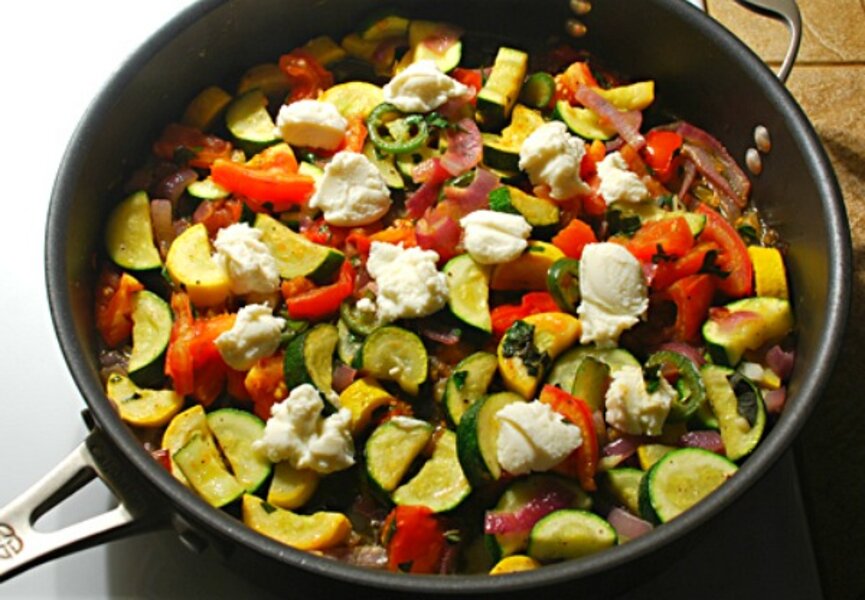Vegetables become en vogue
A new day is dawning for vegetables in the culinary world. No longer are they just rogue companions to humorless rice on the plates of vegetarians. Veggies, as they are affectionately known, are being embraced by everyone from celebrities to school systems to home cooks. Even European chefs, who once disdained vegetarian food as a form of punishment, have elevated baby peas and Brussels sprouts to levels of haute cuisine.
It’s a position that hasn’t been easily won. Ever since Frances Moore Lappé’s “Diet for Small Planet” took off as a bestseller in 1971 – declaring that more resources were used to raise cattle than feed the world – eschewing meat has been something of a political statement that railed against food waste and the unethical treatment of farm animals. For decades, nonmeat eaters and vegetables sagged under the labels of “vegetarian” and “agenda.”
But suddenly wild ramps and zucchini blossoms are hip, and school children, who once fled at the sight of spinach, now munch on sesame kale chips with gusto. Take note: Vegetables are en vouge.
“I’ve always struggled with the ‘vegetarian’ label,” cookbook said author Deborah Madison, who has written about vegetables for more than three decades, to The Washington Post. “When I began writing it was so much about a lifestyle. You were or you weren’t and people didn’t cross that line.” Ms. Madison has recently published “Vegetable Literacy,” which strives to educate home cooks on the delight of discovering flavor relationships within the vegetable family tree.
Eating less meat has had its periodic revolutions in American culinary history. Rev. Sylvester Graham, father of the graham cracker, advocated against eating meat, pepper, and milled flour in the 1830s. A Vegetarian Society gained traction in the mid 1800s. During World War I the United States Food Administration promoted Meatless Monday and Wheatless Wednesday to save resources, and during World War II the government asked Americans to cut back on meat consumption and grow their own vegetables in Victory Gardens to support the war effort abroad.
While those efforts faded after World War II, Meatless Monday was reintroduced in 2003 as a public health awareness program as part of Johns Hopkins Bloomberg School of Public Health. Britain adopted a similar campaign in 2009, Meat Free Monday, launched by rocker Paul McCartney and his daughters Stella and Mary.
In fact, Mary McCartney has just published a cookbook, “Food: Vegetarian home cooking.” The mission of her cookbook is simply, “food that’s healthy but doesn’t feel righteous,” she told The New York Times, thankful the political discussions that would inevitably flare up when carnivores discovered she was a vegetarian are mostly a thing of the past. “I was shocked by how many debates I’d get into when I had dinner,” she told the Times. “Excuse me, I just met you, I’m having dinner – why are you on my case?”
In addition, best-selling author Michael Pollan (“Ominvore’s Dilemma,” “In Defense of Food”) has advocated for an American diet of less meat and more plants. And New York Times minimalist-cook-turned-food-columnist Mark Bittman has recently published “VB6,” shorthand for “vegan before 6 p.m.,” as a life-transforming manifesto he swears by for better health.
But while environmental and diet advocates have long rallied under the banner of carrots, peas, and beets, it seems that vegetable-based diets are finally catching on at the alfalfa sprout level.
In February, Los Angeles public schools adopted Meatless Monday in its citywide school lunch program. A school in New York City, however, has taken it one step further.
“P.S. 244 in Flushing has about 400 students in pre-K through 3rd grade who now munch on meatless meals every day of the week, and if they’re buying their lunch these days – they’ve gone veggie,” reported PIX Channel 11 at the end of April. “The school started by serving meatless meals three days a week, and gradually increased to four, before announcing they’d dropped it altogether....”
As a culinary renaissance continues to gain momentum in the US with two 24-hour cable channels dedicated to food, scores of food bloggers, and an avalanche of cookbooks infused with ethnic cuisine, the average diner’s palate is reaching a new level of sophistication. And suddenly, more people are open to the possibility of vegetables carrying the main course of a meal.
“We’ve brought so many cultural influences into the conversation,” Diane Morgan, author of “Roots,” told The Washington Post. “The granola-era people weren’t making risotto. They were turning spaghetti and meatballs into something else – the meatballs had brown rice, but they weren’t sophisticated. Now the volume of ethnic cookbooks coming into the conversation changes that.”
Indeed, vegetarian and vegan diets have long culinary traditions in Asian cultures. But perhaps the most stunning sign of a vegetable was recently reported by The Wall Street Journal declaring that, “haute-vegetarian menus are conquering Europe.”
“There is a growing demand for vegetarian dishes from our clientele, which is very international,” chef Christophe Moret of Paris’ Lasserre told the Journal.
Food writer Alexander Lobrano was skeptical of this new direction but even he became a convert once he tasted what highly skilled chefs could do with the humble offerings of the ground. “I am convinced we’ve left the hair-shirt brand of vegetarian gastronomy behind,” he wrote.
Vegetable lovers, rejoice.







